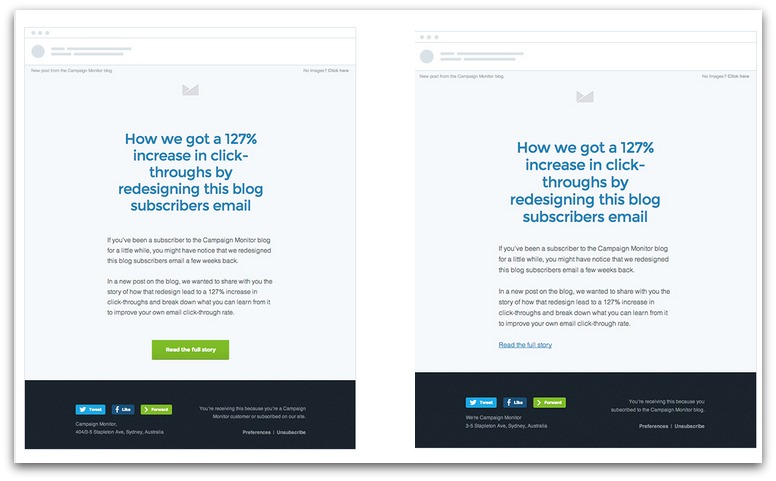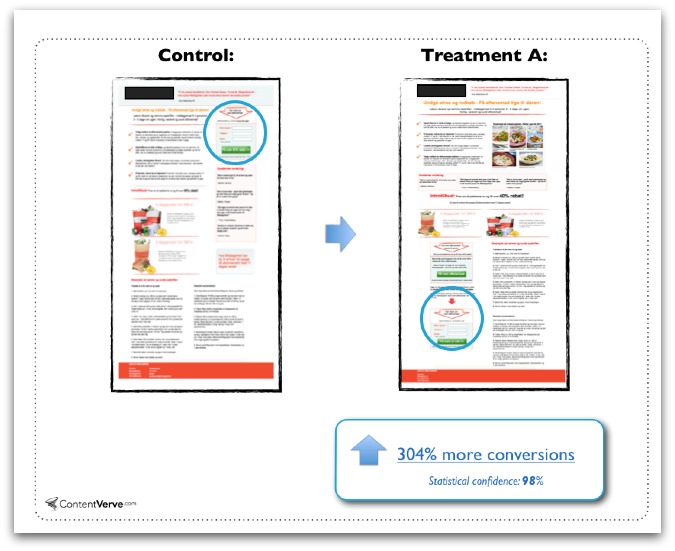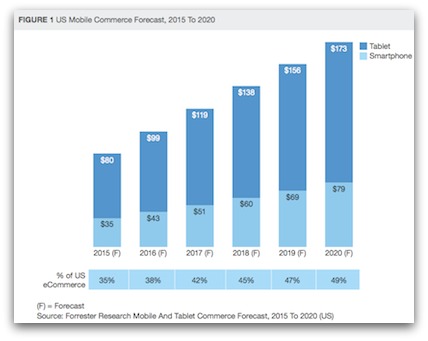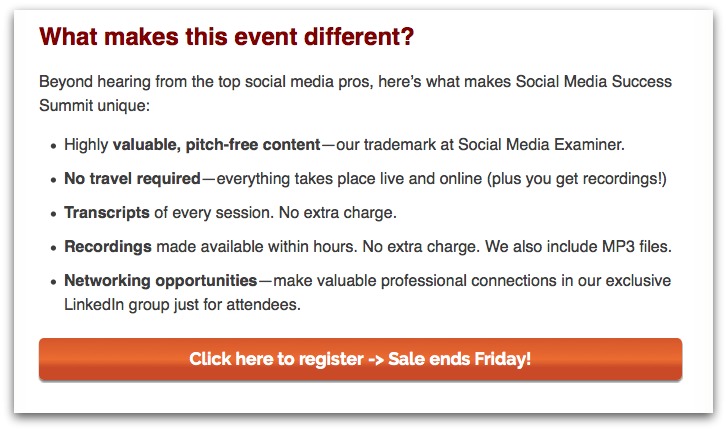You’re proud of your website.
You’ve worked hard on your offers.
You think you know your audience like the back of your hand.
But no one is clicking through on your calls to action. Your site traffic isn’t converting. And it’s driving you nuts.

You can’t figure out where you’re going wrong. So what’s the deal?
Why Your Calls to Action Aren’t Performing Like They Should
In reality, there are many, many different reasons why your calls to action (CTAs) aren’t performing and you’re not getting the results you want. Maybe:
- You’re overwhelming users with too many options.
- Your CTAs are hard to find.
- Your CTAs aren’t optimized for mobile.
- You’re using the wrong language.
- You're using a form that’s WAY too long and complicated.
- You’re asking too much without offering anything in return.
- You’ve left out the benefits of your offer.
- Your color choices are all wrong.
- You’re leaning on a single conversion point.
The good news is: You can fix those lackluster CTAs and start converting like you’re supposed to be.
It’s simply a matter of diagnosing the problem and making the repair. Think of yourself as a CTA mechanic. It’s time to lift up the hood, and figure out where the issue lies, and fix it–so you can get back to on the road to riches.
Want to learn from the pros? Register for Thursday’s list building workshop TODAY today and 2x your conversions on your CTAs with even more copywriting secrets.
Click Here to register for Thursday’s free workshop.
Ready to get started? Let’s look at some of these common problems for CTAs in greater detail, as well as how you can fix them.

CTA Mistake #1: You’re Overwhelming Users with Too Many Calls to Action
Ever look in your closet (which is almost always chock full of outfit options from shopping trips past) and thought to yourself: “I have nothing to wear?”
You might be falling into the decision fatigue trap, which triggers analysis paralysis. When you’ve experienced this, I bet you’ve just fallen back on that same pair of old jeans you’ve worn every other day this week.
You may be activating the same phenomenon for your visitors with your website, by overloading their brains with too many possibilities.
Sheena Iyengar, a professor at Columbia Business School, spoke about the art of choosing in a TED talk she gave in 2010. She said, “Too many choices can overwhelm us and cause us to not choose at all. For businesses, this means that if they offer us too many choices, we may not buy anything.”
She proved this to be true with a study that showed significantly more conversions happened when shoppers had fewer options when making a choice.
In the study, shoppers had to choose from a display with six different flavors of jam versus a display with 24 different flavors of jam.

And guess what? The conversion rate for the six-flavor table was 30%, while the 24-flavor table was only 3%. Less is more, people. Less is more.
So what does jam selection have to do with your calls to action?
Much like too many choices can be a bad thing when it comes to choosing a jam, too many calls to action can also be overwhelming.
Need an example? Just take a look at a site like Walmart and see if you can count all of the different calls to action you’ll find there.

They have CTAs for:
- Finding a local store
- A savings showcase
- Tips & Ideas
- A free shipping pass
- Featured products (which are completely random and not personalized, by the way)
- Products by category
There are at least 20 different CTAs here. AND THIS IS ALL ABOVE THE FOLD. It’s a little much, don’t you think?
In contrast, take a look at a site like Airbnb’s.

On their homepage, they use a single, uncluttered call to action. You don’t have multiple calls to action that distract your attention and scream, “CLICK ME! NO, CLICK ME!”
Airbnb’s single call to action encourages the visitor to start the journey down the funnel without any alternative paths to get in the way of conversion. They put all of the focus on the one CTA they want site visitors to use–which is to explore their options for bookings around the world.
So, what can you do if too many CTAs are hurting your conversion rate?
How to Fix It
Know Your Main Goal
If you’re asking people to do too many different things (like follow you on social media, join your email list, get this content upgrade, etc.), then you’re likely overshadowing your main goal with lots of other little goals. Focus on one main goal for conversion, and then use your CTAs to drive people through that specific funnel.
A/B Test to Find Which CTAs Actually Convert
To be strategic about which CTAs you eliminate during your de-cluttering process, deploy some A/B tests. This process will help you determine exactly which calls to action need to go. You could also review heat maps to see which CTAs are rarely getting clicked.
Reduce Your Number of CTAs
Next, eliminate the low-performing CTAs that get in the way of a site visitor and whittle your way down to the single most important path to conversion. Once you’ve eliminated the multiple CTAs begging for the user’s attention, you can focus on driving them down a single, clear path.
Boom. You just created a stronger CTA.
But maybe for you, it’s not a matter of too many distractions. Next up, ask yourself, “Are your CTAs overworking your visitors?”
CTA Mistake #2: You’re Making Your Visitor Work Too Hard
In the same way too many CTAs can feel overwhelming, asking for too much information can inhibit performance of your conversion assets, too.
You’ve probably experienced this firsthand. Maybe you looked at the opt-in for an eBook or newsletter and thought, “Ugh. That looks like a lot of work. Is this really worth it?” Like this one, for example:

Completing that opt-in is a serious time investment.
Asking for too much user information during the opt-in process can make the user second-guess conversion. Data proves that asking for less info in opt-in forms has a positive impact on conversion.
Dan Zarella found that conversion rate increases by as much as 50% when you cut down the number of form fields from four to three.

ImageScape found similar results when they reduced their number of form fields from 11 down to four: Their conversion rate jumped 120%.

So what can you do to clean up the opt-ins attached to your calls to action?
How you can fix it
Only ask for must-have data. If you need to collect more customer data down the road, you can. But if you want to increase conversions, you need your opt-ins to chill.
Make some fields optional. If you still want to leave the option open for leads or customers to share other pieces of data with you, indicate that those form fields optional.
Just remember: The more you ask of users, the less likely they are to convert. Consider how valuable that extra form field is to your business in the face of overall conversions.
From here, think about CTA positioning.
CTA Mistake #3: No One Can Find Your Call to Action
Sometimes, calls to action don’t perform because users simply can’t find them.
They’re either buried in text and graphics, they’re too far down on the page, they’re not in the common sight/mouse traffic area, or they’re a text link instead of a prominent button that stands out from the rest of the page.

And, yeah, it’s not surprising that CTAs don’t convert when users can’t easily find them.
But what is surprising is how much the conversion rate can increase when they ARE easy to find.
One label company found that adding a prominent CTA button increased conversions by a whopping 62%.
Other times, it’s the wrong type of call to action that’s hurting your conversion rate performance.
Email platform Campaign Monitor discovered that using a CTA button instead of a CTA text link increased their conversion rate by 127%.

Interesting, right? Translation: You need to determine RIGHT NOW whether or not your audience can find your calls to action.
Register for Thursday’s FREE list building workshop to learn from our CEO about exactly where to put your CTAs to get a 10% conversion rate – or more.
Click Here to register for Thursday’s free workshop.
How to Fix It
To repair a hard-to-find call to action, you need to gather some initial user data so you’re not just grabbing at straws when you implement changes. You can:
A/B test a your current text link CTA vs. a prominent button CTA (or simply testing two differently formatted CTAs.)
Check out your content analytics to see if your site visitors are scrolling down the part of the page where your call to action lies.
In doing this, you’ll have a much better idea of your users’ CTA-related needs.
These methods are proven to work, too. Bros Leather used heat maps to ensure customers were clicking on important parts of their product pages (like product images and the CTA ‘Buy’ button.) As a result, they were able to ensure these conversion-driving resources were properly positioned–and thus increased the likelihood for conversion.

Once you’ve used these resources to determine how you’ll make your CTA more prominent and easy to find, you should also consider some of these additional best practices for creating high performing calls to action.
- Leverage whitespace. Don’t crowd your CTA. Give it room to breathe so it stands out from the page. A UX study showed that making use of whitespace increases comprehension by as much as 20%. An example of sufficient whitespace around a CTA can be seen on Tim Ferriss’s {Four Hour WorkWeek](http://fourhourworkweek.com/) site:

Notice how the buttons aren’t crowded or lumped in with other copy: They stand out because they have an abundance of negative space around them.
- Consider placing your CTAs below the fold. Smart, benefit-driven copy helps move a visitor down the page and helps explain the value proposition to conversion before making the ask. ContentVerve conducted an A/B test that found placing the CTA below the fold increased conversions by an incredible 304%.

Once your CTAs are well positioned, you’ll want to make sure they’re mobile-friendly.
CTA Mistake #4: Your Call to Action Isn’t Optimized for Mobile
Your calls to action might seem like they’re from Sucktown, USA because they’re not optimized for mobile users.

You know how frustrating non-mobile websites can be. Can you imagine trying to click the CTAs on the non-mobile version above (left)? When you end up on one of these pages, you probably don’t even bother pinching and zooming to try to get to those CTAs. Too much work.
And guess what? People are spending more time on their mobile devices than on their desktop computers than ever before. The increase in mobile usage is staggering–and it’s increasing at an incredible speed.
In 2014, a comScore report showed that the number of mobile users surpassed the number of desktop users.

Then in 2015, Google reported there were officially more mobile searches than desktop searches overall. Add to this the fact that mobile spending is quickly growing, bringing in a projected $142B for retailers in 2016.

And what’s more: These incredible numbers are all in the face of surprisingly low mobile conversion rates overall.
While ecommerce conversion rates for mobile devices are still on the low end of the spectrum, data shows that they’re on the rise–and that means there’s a lot of room for growth.
- Smartphone conversions globally increased from 1.2% back in Q4 of 2014 to 1.53% in Q4 of 2015.
- Tablet conversions globally increased from 3.41% in Q4 of 2014 to 3.75% in Q4 of 2015.

Translation: You need mobile-friendly CTAs. The increase in mobile traffic isn’t a trend or fad–it’s actually likely to continue increasing, if anything. If you haven’t already, it’s time for you to make changes and cater to your mobile users, too.
How to Fix It
Optimize for Mobile
Make sure your website, landing pages, and other marketing efforts (like email, for example) are optimized for mobile. This helps guarantee your text, images, and CTAs are correctly displaying (and are easy to read) on a variety of mobile devices.
If these elements aren’t mobile-friendly, you’re creating an awful experience for the user by making them pinch and zoom to try and read your shiz.
Look Neil Patel’s comparison example of a mobile friendly vs. non-mobile friendly CTA:

See the difference?
A few key points to keep in mind for mobile optimization of calls to action:
-
Buttons need to be large and not crowded. Remember: people use their fingertips to click on things on mobile devices. If your CTAs are too small or close together, it will create a miserable user experience, and you’ll likely frustrate the person trying to use your call to action.
-
You’re working with smaller screen sizes, so less is more. Strive for a layout that’s clean and easy to navigate.
Now let’s chat about CTA copy, shall we?
CTA Mistake #5: You’re Using the Wrong Words/Not Enough Words
The words you’re using in conjunction with your call to action matter more than you think.

Which wording is more compelling to you? The one that invites you to to try something, or the one that demands you to make a purchase?
In our guide on copywriting hacks for calls to action, we discussed many different ways a slight tweak in your wording can make a positive impact on your conversion rate and pointed out some of the major don’ts, too. Those don’ts include:
- Using generic wording
- Using the same CTA wording for distinctly different segments
- Using 2nd or 3rd person in CTA copy
- Using cumbersome action verbs
- Omitting a sense of urgency
- Forgetting to address your lead’s anxieties and concerns
- Leaving out your value proposition
Any of those sound familiar? If so, you may need to take a second look at the copy on and around your CTA. Here are a few ways you can resolve these word-related issues.
How to Fix It
Use First Person
Research and A/B tests indicate that using ‘my’ instead of ‘your’ in CTA text is often much more effective at driving conversions. In fact, when Schedulicity tested a first person vs. third person CTA, they found that the third person version (using ‘my’) boosted conversions by 24%.

Remove Friction Words
Joana Wiebe of Copyhackers reminds us that friction words make the reader feel like he or she has to give something up in order to attain the offer on the other side of the CTA. These are words like:
- Buy
- Sign Up
- Submit
- Give
- Invest
- Donate
- Sponsor
- Support
- Complete
If they’re part of your current CTA, they’ve gotta go.
Leverage Microcopy
It could also be that you’re not using enough words in your call to action.
Microcopy is the text you see on and around calls to action that is both instructional and encouraging for the reader. It helps eliminate uncertainty and anxiety about what’s on the other side of the call to action by providing some additional details that reassure the reader it’s worthwhile to pursue.
It also answers questions, like, “What happens when I click here?” or, “What should I search for?”
Take a look at this example from Misterbandb. Notice the microcopy within the boxes that tell the site visitor exactly what to do within those spaces to move forward with the conversion process. If you were a new user to this site, the microcopy here would help eliminate any questions you had about how to use the main call to action.

But that’s not the end of the conversation about CTA copy. Now you need to consider what value you’re expressing.
CTA Mistake #6: You’re Asking For Money Before You’ve Provided Value
People end up looking at a call to action you’ve created because you’ve attracted them there somehow. They didn’t open a browser and say, “Internet, show me a random landing page!” They got there on purpose.
But that audience includes a wide variety of people who are at different stages of the sales funnel. Some are ready to take action right away, while others are still debating whether or not this option is right for them.
And if you’re asking them to buy right away without offering something in return…you might be coming in too hot.
With a discount or free offer, you’re creating an opportunity for an initial conversion. From there, you can follow up with them and help move them down the path to taking action and making a purchase.
Getting your foot in the door with this early conversion can help drive up other conversion rates down the road (like, ahem, sales.)
We do this on our homepage:

Why? Because not only does it let users experiment with our products and figure out if they actually want to become a customer, but it also provides an initial point of contact that allows us to follow up with people who expressed interest in our product. It’s [sales funneling 101(https://bdow.com/stories/sales-funnel-for-blogs).
So how can you use one of these free trial/discount CTAs to increase your conversion performance overall?
How to Fix It
Establish A Free Trial/Discount Offer
Depending on your business, it might make more sense for you to offer a free trial or a small 10-15% off discount as a way to establish that initial relationship with potential customers. Make sure you’re collecting a name and email address, but keeping the opt-in simple.
Fine-Tune Your Sales Funnel
From here, continue the conversation with these leads and offer them value on an on-going basis. Follow up via email. Ask for more details about their needs. Continue to drip helpful, relevant content to them so they can move further down the path to conversion.
If you do this well, when it’s finally time for you to present that sales-oriented CTA, you can expect stronger performance (and more sales.)
Think about it: You’ve earned their trust and offered lots of helpful tools and resources along the way. Why wouldn’t they want to move forward?
Speaking of value, how about the benefits of your CTA? Are you leveraging those?
CTA Mistake #7: You’re Leaving Out the Benefits
Quick experiment. Look at two different offers.
- Offer #1: Our eBook on Email List Growth
- Offer #2: 5 Steps to Getting 10,000 Email Subscribers in 6 Months (FREE eBook!)
Which is more appealing? Ummm, it’s offer #2, guys.
Why is that? One word: BENEFITS.
Generic copy that doesn’t tout the benefits of your CTA will struggle to motivate people because it forgets the “What’s in it for me?” mentality of the average human being.
Yeah, we’re selfish creatures. Deal with it.
So what does this look like in a real-life example? Check out the benefits leveraged in this CTA from Social Media Examiner:

LOOK AT ALL OF THOSE BENEFITS! Beautiful. Notice how they make attending this event sound easy, interesting, and valuable by extrapolating on the benefits of the format they’ve chosen.
If you’re not currently speaking to the benefits of your own CTA, here’s how you can remedy the situation.
How to Fix It
-
Be specific about benefits. It’s not enough to throw in words like ‘free’ and ‘valuable.’ You need to explain why the benefits are so worthwhile, and what specific outcomes the user can expect as a result of taking action.
-
Speak to pain points. You know what your target demographic struggles with, so tease out those areas of friction in their lives, and then tell them how you’re going to solve those problems.
-
Don’t stop at one. Use different angles to drive home your benefits and expand on a variety of benefits your CTA can offer.
Once your copy is benefit-loaded and sparkling, make sure your CTA button is easy to spot.
CTA Mistake #8: You're Not Using an Action Color
Is there a magic button color that guarantees higher conversion rates? Nope.
In fact, ConversionXL conducted extensive research, and concluded the following: “Saying that one color converts better than another is simply stupid. There is no universal best color. What works on one site, doesn’t necessarily work on another.”
And, yes: While some studies have indicated certain button shapes and colors outperform others (like the example below from ContentVerve), it doesn’t mean there’s a surefire button color for each and every use case.

Think about it: If you thought that green was the only acceptable color for CTA buttons, and you placed them on the green background of your website, would they still be super effective? No way. They’d blend right in. The thing to remember with CTAs and color is that context is key.
That’s why you need to choose an action color: A color for your CTA button that makes it stand out from the page as an obvious action point.
If your buttons aren’t performing because you’re not using an action color, here’s what you need to know.
How to Fix It
- Make CTA buttons a color that contrasts against the background. In doing this, you’re ensuring they’re easy to spot on the screen. For example, look at how Fedora uses navy blue buttons against its white backdrop to make them pop from the page.

- A/B Test Different Colors. You’ll find your best action color by conducting some A/B tests and getting hard numbers that indicate which color works best for your audience. Otherwise, you’re just guessing.
Once you’ve nailed down your button action color that drives conversions, you’ve still got one more thing to consider–the number of opportunities you’re presenting for conversion.
CTA Mistake #9: Your Follow Up Is Lacking
If you’re leaning on a single CTA to drive all of your conversions, you’ve likely got some room for improvement.
Why? Because you’re missing out on follow-up opportunities that could boost your conversion rate. Don’t put all your eggs in one basket–create multiple opportunities for a user to start the path down the conversion funnel and follow up with them in case they didn’t follow-through on your first offer.
For example: Maybe the visitor isn’t ready to convert when you present the welcome mat opt-in, but after reading your amazing blog post, that visitor is thinking, “Okay, they really know their stuff.”
NOW you’ve got that visitor in the mindframe to convert–but without any follow-up CTAs, you’re depending on that user to hunt down the single conversion point. That’s frustrating. Make it easy for your CTA to perform by placing it in multiple spots around the page.
Want to see what that might look like in action?
How to Fix It
There are a few different ways you can create more opportunities for follow up.
For example: Say you’re trying to drive conversions for newsletter signups on a particular blog post. You have a CTA in your welcome mat that greets the reader at the top of the page, but then you also have other conversion opportunities, such as:
- Text links to your CTAs within the text
- An exit intent popup that populates when a user is about to leave the page

- A CTA at the bottom of the post

- A sidebar CTA

See how this approach gives the reader four different ways to convert? Nice.
Just remember: Your CTAs should be working together toward a single goal, not fighting each other for the reader’s attention. Create multiple opportunities for conversion without overwhelming your audience with too many different conversion paths. Keep it focused.
Spot the Problems, Fix ‘Em, And Make Your Calls to Action Perform Better Than Ever Before
It’s time for a quick recap, folks.
Performance suffers when your CTAs:
- Overload users with too many options.
- Are hard to find on the page.
- Look like garbage on a mobile device.
- Use the wrong words and don’t incorporate smart copy.
- Include mile-long forms with a gazillion different fields.
- Don’t entice leads with some sort of offer/discount in return.
- Don’t use colors that pop from the page and make the conversion path obvious.
- Forget to mention all of the kick ass benefits.
- Don’t give the user enough opportunities to take action.
If you’ve read to this point, you know exactly how to fix these problems, and once you’ve tested some of the changes we’ve suggested here, you should be seeing conversion rates for your CTAs take an upward trajectory. That sounds pretty nice, right? Of course it does.
Need more CTA help? You’re in luck. We’re holding a FREE workshop with our CEO, Noah Kagan, to help you increase your conversion rates on your CTAs.
Add A Comment
VIEW THE COMMENTS